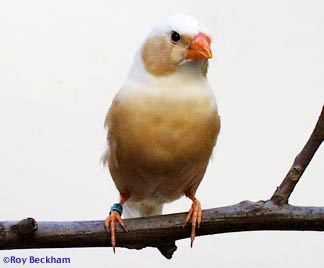What kind of Zebra
- Crystal
- Brooding

- Posts: 1331
- Joined: Sat Feb 11, 2006 2:27 pm
- Location: Richmond, VA
- Contact:
- Crystal
- Brooding

- Posts: 1331
- Joined: Sat Feb 11, 2006 2:27 pm
- Location: Richmond, VA
- Contact:
Males sing & females lay eggs. If you end up with a nest with a large number of eggs (8-10+) and none are fertile, you have probably paired two hens.
Webmaster
http://www.finchinfo.com/
http://www.finchinfo.com/
- Crystal
- Brooding

- Posts: 1331
- Joined: Sat Feb 11, 2006 2:27 pm
- Location: Richmond, VA
- Contact:
You could also DNA sex them (may be a little bit overkill):
http://www.efinch.com/dna_sexing/dna_sexing.htm
http://www.efinch.com/dna_sexing/dna_sexing.htm
Webmaster
http://www.finchinfo.com/
http://www.finchinfo.com/
- tammieb
- Brooding

- Posts: 1241
- Joined: Sat Feb 11, 2006 7:00 pm
- Location: USA/Nebraska
- Contact:
- Crystal
- Brooding

- Posts: 1331
- Joined: Sat Feb 11, 2006 2:27 pm
- Location: Richmond, VA
- Contact:
There are a couple mutations like that (black cheeks, fawn cheeks, gray cheeks). Usually you won't find them unless you're looking for them (i.e. purchasing from a breeder).
Webmaster
http://www.finchinfo.com/
http://www.finchinfo.com/
-
tina
- Mature

- Posts: 146
- Joined: Thu Jul 27, 2006 8:33 am
- Location: Kansas
I have a black cheek hen, the beak color is a option, but not reliable one, best to wait for singing from male and/or eggs. Normally the male will sing alot of the time, so if there has been no singing at all I would wonder.
If you do have one of the cheeked mutations, the cheeked males do have all the other marking of the regular color too, just colored different. That is how you would tell those apart since the female only has the cheeks, and the males have the chest stripes and flanks that are spotted as well. The question is finding the mutation you have. The cheeked ones also have the tear stains that appear on the normal and more common mutations.
This is a gray cheeked male for example:
 Photo by NZC
Photo by NZC
If you do have one of the cheeked mutations, the cheeked males do have all the other marking of the regular color too, just colored different. That is how you would tell those apart since the female only has the cheeks, and the males have the chest stripes and flanks that are spotted as well. The question is finding the mutation you have. The cheeked ones also have the tear stains that appear on the normal and more common mutations.
This is a gray cheeked male for example:
 Photo by NZC
Photo by NZCThank you,
Tina
Tina
-
kdinkel
- Pip

- Posts: 16
- Joined: Mon Nov 20, 2006 6:19 pm
Thanks for the help. We have had him for 2 weeks and no singing (if you mean the chirping type noises our other male did constantly) so I must assume it is a female. I guess I am on the search for a male again. The petstore also had some all white ones with just black tear stains. Is that a white male? If we end up with two males will they both sing\fight?
-
tina
- Mature

- Posts: 146
- Joined: Thu Jul 27, 2006 8:33 am
- Location: Kansas
All white with just a tear stain is a cfw female. The male has cheek patches and barring on the throat and flanks with some color and spots.
I also tend to think you have a isabel fawn hen, (isabel is a different name for florida fancy by the way). males and female will generally get along if there is none is the opposite sex around. I have had females fight when place 2 to 1 male also. my own experience is that males will fight if females are around where they can see them or hear them, or if you have 2 pairs in the same cage. 3 or more pairs in the same cage and no fighting. I have no idea why that is but for some reason having a larger group seems to make peace with them.
I also tend to think you have a isabel fawn hen, (isabel is a different name for florida fancy by the way). males and female will generally get along if there is none is the opposite sex around. I have had females fight when place 2 to 1 male also. my own experience is that males will fight if females are around where they can see them or hear them, or if you have 2 pairs in the same cage. 3 or more pairs in the same cage and no fighting. I have no idea why that is but for some reason having a larger group seems to make peace with them.
Thank you,
Tina
Tina
- tammieb
- Brooding

- Posts: 1241
- Joined: Sat Feb 11, 2006 7:00 pm
- Location: USA/Nebraska
- Contact:
Try this site, http://www.efinch.com/varieties.htm
TammieB.
Use the talents you possess - for the woods would be a very silent place if no birds sang except for the best. ~Henry Van Dyke~
Use the talents you possess - for the woods would be a very silent place if no birds sang except for the best. ~Henry Van Dyke~
-
kdinkel
- Pip

- Posts: 16
- Joined: Mon Nov 20, 2006 6:19 pm
Thanks a ton for all the help. I went back to the petstore and got a new male. This one still looks like a fawn cheek, but has the markings the male version needs (Just like the pic the grey cheek in tina's post only a more fawn color). We will sell\trade in the standard color female and keep the one I thought was a male (fawn cheek). Thanks again!
